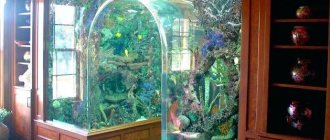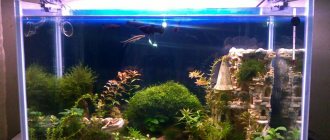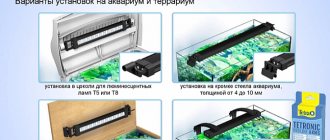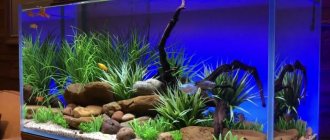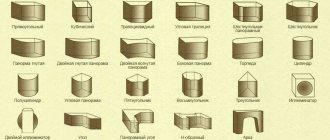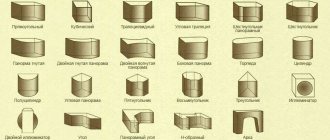Glass for aquarium.
Aquarium – which glass to choose?
Glass for an aquarium is selected in accordance with strength, optical and design requirements. The first condition affects the choice of thickness and size of glass for the aquarium, as well as the use of tempered glass. Second, you can choose between bleached glass (possibly anti-reflective) or regular glass. And the requirements for the design of the room where the aquarium is installed may lead to the use of tinted glass.
Aquarium glass thickness.
Aquarium glass
The thickness of glass for an aquarium is selected according to the table; additional clarifying calculations are required only for highly loaded structures. Typically, glass thicknesses from 4 mm to 19 mm are used, the most popular being 6 mm thick aquarium glass.
Aquarium glass size.
Glass sizes for an aquarium can be calculated using any of the numerous aquarium calculators available on the Internet. The calculation will give the exact dimensions of each side glass, taking into account the choice of installation on the bottom or at the joint to the bottom. Regardless of the method of joining the day and sides, the calculator will give the dimensions of the glass, taking into account allowances for installation.
Proportions are important for making an aquarium!
The most reliable when calculating strength is an aquarium in the shape of a cube. But often, if the length, width and height of the aquarium are equal, the product does not have the most suitable appearance, and it is difficult to observe the fish in the water column. For a more visually interesting presentation of the contents of the aquarium, the following recommendations are usually followed: the length of the aquarium is 1.5 - 2 times greater than its width, and the height is 10-20 percent greater than the width. Of course, the size of the aquarium depends on the purpose - from tall and narrow exhibition aquariums to special spawning or quarantine aquariums.
Calculator: what is it, what is it for, what are they?
Calculators are commonly called electronic computing devices that have replaced mechanical ones and perform operations on numbers and algebraic formulas.
Among them there are specialized ones that perform calculations in one very narrow area. This is what an aquarium calculator is like. What can be calculated using it:
- glass thickness;
- water volume;
- volume and mass of soil;
- amount of fertilizers;
- lighting power;
- heater power;
- carbon dioxide content;
- fish stocking density.
There are calculators for rectangular, cubic, corner, panoramic, and cylinder aquariums.
Calculation of glass for an aquarium.
Aquarium glass calculator.
Calculation of glass sizes for an aquarium can be done using any online calculator, of which there are many on the Internet. As a result of the calculation, in addition to the dimensions of the glass, taking into account allowances for glass thickness, you can also obtain the amount of sealant required, as well as recommendations for the use of stiffeners and lintels.
The surface area of the aquarium glass.
Calculating the surface area of the aquarium is used when calculating the cost of the final product. But this is too generalized information and an accurate calculation of the cost of glass for an aquarium can only be obtained by element-by-element calculation of each glass part. This calculation can be made on our website in the Calculator section.
Calculation of glass thickness for an aquarium.
For a general assessment of the required glass thickness, it is enough to use the table with the recommended thickness depending on the size of the aquarium walls. There is no need to make an exact calculation using load diagrams from the strength of strength material course; it is enough to follow the general recommendations and, for greater confidence, use stiffeners or, in extreme cases, switch to tempered glass.
Choosing a high-quality and reliable aquarium
UViAQUA.com
Choosing a high-quality and reliable aquarium
00:00/ 12:35
Anchor Google Play Listen Notes Player.fm Stitcher iTunes
RSS Feed
Share
Link
Embed
| Play in new window | Duration: 12:35
Subscribe: Anchor | Google Play | Listen Notes | Player.fm | Stitcher | iTunes
Yu.V.
— Ir, do you remember that you were going to get yourself a new aquarium? Have you decided?
Tekhi
- In progress, Yuri. By the way, it’s good that you reminded me, I wanted to ask you how best to choose an aquarium? What to look for? What to look for? I mean in terms of its durability and reliability.
Yu.V.
- Look, Ir, you need a lot of things. And watch carefully.
Firstly, you need to look at the thickness of the glass and its compliance with the size of the aquarium. The higher and longer the aquarium, the thicker the glass should be.
Tekhi
— Doesn’t the width of the aquarium (well, which aquarists call “depth”) play a role?
Yu.V.
- No, she has no business here. And even if she is asked to contribute some calculators for calculating the thickness of the aquarium glass, this is solely to create the appearance of her own coolness, she does not take part in the calculation
Tekhi
— Calculators? Are there any?
Yu.V.
- Yes, of course there is. After choosing the size of aquarium that suits you, you have to make one fundamental choice.
Tekhi
- Which?
Yu.V.
- Decide whether you will have an aquarium with a lid, or whether you will have it open.
Tekhi
- An open one is more beautiful!... And you can put any lamp on an open one, and not have to worry about placing a decent light in the lid...
Yu.V.
- It also humidifies the air in the room better and you need to add water to it more often. )) An aquarium with a lid also has advantages - nothing will fall into it, at least accidentally, fish will not jump out of it, and less water evaporates from it.
Tekhi
— And cats like to sleep on it?
Yu.V.
- They love it, yes. But the main thing is that an aquarium with a lid can easily be made with stiffening ribs and ties, and this will not spoil the view, as it would spoil it in the open.
Tekhi
- Why do we need ribs and ties? They make it so difficult to serve him!
Yu.V.
— If it is possible to install stiffening ribs and ties, then this allows you to make an aquarium from thinner glass. And much more subtle. This means the aquarium will be significantly cheaper.
Tekhi
- Yur, what are they like, these ribs and ties?
Yu.V.
- They are different, Irish. The most classic and common option is when glass stiffeners are glued to the long glass of the aquarium in its upper part. This significantly increases the rigidity of the glass and in some cases even allows you to do without a screed.
Well, if you can’t do without it (well, or “without them” - on long and tall aquariums there can be two, three, or more), then a glass screed is already glued to the ribs. The glass is usually the same thickness as the main glass of the aquarium.
Tekhi
- What beauty it is under water!
Yu.V.
- Still would.
This is Olya Podgornaya's aquarium. You know her as slalf .
By the way, about glass. Glass can be ordinary and so-called. “super transparent”. People call it “optiwhite.” They differ essentially only in color. The usual one in a thick layer looks a little greenish, but the super transparent one, “optiwhite”, which has absolutely no tint. But this is noticeable only with glass thicknesses over 6-8 mm. Therefore, if the glass is thin, then there is no point in bothering and spending extra money on Optiwhite.
Tekhi
— Yuri, since we are distracted by glass, please tell me, what do you think about the use of triplex in aquariums? Is it much stronger?
Yu.V.
- Yes, stronger. But I came across situations a couple of times when under load (and water pressure is a load!) the glass delaminated. I don’t dare say it was low-quality glass or something else, but I haven’t recognized it since then. I don’t know, maybe since those times technology has stepped forward and it has become safer, but I prefer to make a better allowance for the thickness of the glass.
Tekhi
- I realized thanks. Yes, so let's get back to the tie ribs? What other types are there?
Yu.V.
— Serious manufacturers, Ir, of course, know about the problem of aesthetics, and are trying to solve this issue. This is how, for example, he glues his JUWEL screed to glass.
With this design, they even manage to do without stiffeners.
And here’s how elegantly (there’s no other way to say it) FERPLAST solved this problem.
There is a neat frame at the top of the aquarium and cables are installed in its grooves. I really like it! And also, by the way, without ribs.
Yes, so we got distracted. Having decided on the dimensions of your future aquarium and deciding whether you will have it open (we read - without ribs and ties) or with a lid (and then with them), you enter these dimensions into the calculator, mark “without” or “with” and you get the result - how thick the glass should be in order for it to be reliable.
Tekhi
— Which calculator is better, Yuri?
Yu.V.
- Any, Ir. There are many of them on the Internet and they all essentially work according to long-calculated tables and give the same result.
And only after that you start choosing an aquarium for yourself. Either ready-made or custom-made.
Tekhi
- And what should you pay attention to here?
Yu.V.
— If you are going to buy, then, having realized that its size, shape and, of course,
the thickness of the glass correspond to your wishes, calculated and measured in advance, you first pay attention to its bottom. If the aquarium is longer than a meter, then it is highly desirable that it have a composite bottom. Made from several glasses.
Tekhi
- Why from several?
Yu.V.
— This reduces the likelihood that the bottom will burst due to some misalignment of the cabinet over time.
Moreover, if the aquarium is longer than 1.5 m, I would also glue strips of glass along the bottom. A type of local “double bottom”. Also for strengthening.
Tekhi
- It's clear…
Yu.V.
— If your aquarium has stiffening ribs, then please pay attention, they should not be from glass to glass for the entire size of the aquarium! There shouldn't even be a silicone seam there. They must not reach the edge of the aquarium 2-3 cm. More is possible.
Tekhi
- Why?
Yu.V.
— Because, whether we like it or not, when filling an aquarium, some deformations occur in its walls. And if the edge is butted, then with such deformation it can damage the adjacent glass.
Well, it is clear that if you choose an aquarium without ribs and ties, then all this should not bother you.
In general, then you look to see if there are any chips on the glass.
It is clear that there should be no chips. And after that you arm yourself with a flashlight and a magnifying glass.
Tekhi
— Should I look at the seams?
Yu.V.
- Exactly! The main requirement for seams is that there should be no air bubbles in them.
Tekhi
- What if they are small and do not extend to the edge of the seam?
Yu.V.
- Ir, well, I said “it shouldn’t be!” Everything else is your personal risk, tied to the eloquence of the seller or manufacturer. A bubble is not only a reduced area of contact between silicone and glass, which means less strength, but also a potential place for moisture to seep in, the appearance of some algae and, ultimately, leakage.
If you really like the aquarium itself so much, then you can forgive the sloppy seam.
Although he, of course, must be careful.
You can even try to forgive the mismatch of glass heights (step).
Although I wouldn’t forgive that either. But I consider bubbles in the seam to be completely unacceptable under any circumstances.
Tekhi
— Yuri, what can you say about the bead on the inner surface of the seam? Is he needed?
Yu.V.
- Oh... Personally, I think the roller is a legal hack. It adds neither strength nor beauty. I believe that a proper seam on the inside should be formed into a neat triangle.
Although, of course, such a seam adds angst to manufacturers and they try to tell them that the roller is no worse.
Well, to finish with the seams, I want to draw your attention to one more point. The silicone used to glue aquariums is not contact glue. It only works fine in a certain layer. Therefore, there is no need to chase thinner seams. The optimal seam should be 1.5-2.0 mm. Minimum 1.0, maximum 2.5.
Tekhi
- Understood!
Yu.V.
— Well, we seem to have sorted out the purchased aquariums.
Tekhi
— Do custom orders have any nuances?
Yu.V.
- Certainly. If manufacturers, especially branded ones, work according to their own internal specifications and standards, then self-adhesive manufacturers and small manufacturers can take certain liberties. Therefore, before ordering, you should familiarize your manufacturer with everything I said above and warn you that you will pay attention to this.
Plus, it would be nice to also specify the quality of the ends of the glass used.
The ends must not be sanded!
Silicone adheres best to smooth surfaces. If this glass is thin (well, up to 5 mm maximum), then it is enough to simply sand the corners, and leave the ends themselves just with the chip that turned out after cutting.
But this, of course, is hackwork, although it does not affect the strength. Ideally, the end of the glass should be polished.
And not only the visible part, but also, first of all, those ends that are in the seams. In this case, the aquarium will be both durable and look beautiful.
Tekhi
— What can you say about the silicone itself?
Yu.V.
— If you have the opportunity to choose, then try to have Dow Corning silicone glued on you. It's very expensive. But among the aquarium silicones I like it the most. First of all, its strength. In general, CHEMLUX, which is more affordable in price, has proven itself well. By the way, it is most loved by small manufacturers precisely because of its good combination of price and quality. And definitely don’t use different nonnames. Silicone is a rather important moment in gluing an aquarium, and you should not skimp on it. By the way, as well as its consumption.
Tekhi
- What about the expense? Can you glue it differently?
Yu.V.
- Certainly. The simplest method, which is loved by all manufacturers, is to spread silicone on the surface of the glass and then compress it. Quite simple and convenient, I agree. And silicone is saved. But the likelihood of bubbles appearing in the seams increases many times over.
But if the gluer assembles the entire aquarium on a stand, all the glass with the required gaps and pushes the silicone through the seam to the opposite side, then most likely there will be no bubbles, and the aquarium will be much stronger and more reliable. True, the consumption of silicone will at least double, if not triple, and plus a decent amount of work will be added to clean the inner surface of the aquarium after the silicone has dried. Yes, price increases. Especially if silicone is expensive. But, IMHO, it's worth it. Especially if he also does not spare alcohol or acetone to completely degrease all bonded surfaces. By the way, as in the case of gluing with a clamp. Don't forget to ask him about this too.
Well, however, in the case of buying a ready-made aquarium, this information is unlikely to be useful to you. )))
Tekhi
- Well, it seems that now I am so armed with information that, in principle, I cannot have a low-quality aquarium!
Yu.V.
“I really hope so, Irish.” And I can’t wait for you to have it! I really want to take part in its launch!
Tekhi
- You will definitely take part! Soon. Thank you so much!
Share link:
Similar
How to make an aquarium out of glass.
Order aquarium glass according to your size.
After strength calculations of the recommended dimensions of the bottom and side walls of the aquarium, you can also make a cost calculation for each element in the Calculator section of our website. To order, just send us the glass parameters by email. In cases where non-standard products are required (different wall heights, cutouts for fittings or fasteners, etc.), a sketch or drawing will be required. Our engineers will evaluate the possibility of production and give their recommendations.
Buy glass for an aquarium from the Steklotrade company.
Buying glass for an aquarium can be as easy and simple as buying regular glass. All you have to do is submit an application and pay the invoice received. The turnaround time is usually 2-3 days. You can receive a finished order directly in the workshops of our company in Moscow
Aquarium glass: price and terms of purchase.
The price of glass for an aquarium does not differ from ordinary glass. Before purchasing, it is important to decide on the type of glass. For more vivid visualization of underwater life, lightened glass is often used, and professional photographers order anti-reflective glass. At the same time, there is no need to make the entire aquarium from such special glasses. In most cases, it is enough to place such glass on the front side and leave the rest of the glass plain. Since glass is cut directly to the client’s dimensions, our company carries out cutting and processing only after 100 percent prepayment.
